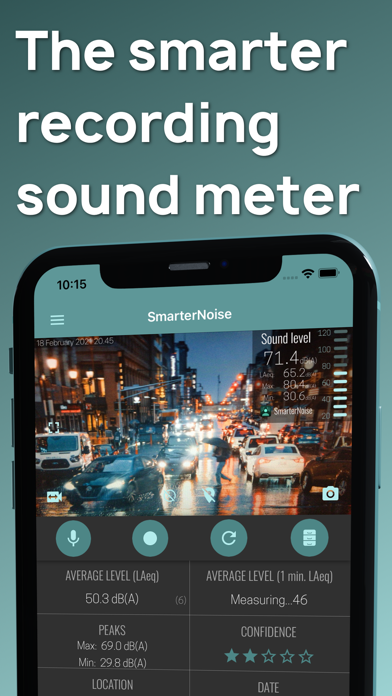
SmarterNoise measures sound level, records video and audio and informs about noise
SmarterNoise is a premium sound level meter app featuring several unique functions. SmarterNoise measures sound levels in video and audio modes, records video and sound, and informs you about the risks of noise exposure. In addition, SmarterNoise includes a camera, measurement location, and easy sharing, all for free. From the archive you can view the video and audio files youve saved on your phone. With SmarterNoise you take sound level and noise measuring to a new level never available before.
SmarterNoise features smart icons that react to the measured sound levels based on current research results focusing on the health and the adverse effects of noise pollution. With the SmarterNoise icons you easily understand how hearing, cognitive performance, and health may be affected by different levels of noise exposure. The awareness of harmful noise is increasing globally, and is considered a versatile risk factor for well-being and health, especially in noise polluted urban environments.
Features of SmarterNoise:
Sound level measurement and recording in video and audio modes
Sound level activated audio recording
Full HD, HD or VGA video resolution
Three video quality settings
Zoom and camera light
Restarting of measurement
Archive for saved files
Sharing of saved files
Calibration
Smart icons
Location, address
Time and date display
10 second sound level average (LAeq, decibel)
60 second sound level average (LAeq, decibel)
Max and min decibel level
About decibels and sound measurement
The unit for measuring noise and sound is called a decibel. Because the decibel scale is logarithmic, a sound with an intensity that is twice that of a reference sound corresponds to an increase of about 3 decibels. The reference point of 0 decibel is set at the intensity of the least perceptible sound, the threshold of hearing. On such a scale a 10-decibel sound is 10 times the intensity of the reference sound. Highlighting this is important as already a difference of a few decibels makes a noticeable difference in how noise is perceived.
Leq is an average value describing the total sound energy over a period of time. It is however common practice to measure sound levels using A-weighting, which attenuates low and high frequencies that the average person cannot hear. In this case Leq is written LAeq. LAeq is a formulated average which emphasizes higher sound peaks, and is one of the most common measurements used by professionals to measure noise. All averages in SmarterNoise are measured in LAeq.
Health effects of noise are often measured in Lden. Lden measures the average sound level over a 24 hour period, with a penalty of 5 dB added for the evening hours between 19:00 and 22:00, and a penalty of 10 dB added for the nighttime hours between 22:00 and 07:00. Increased health risks have been observed during long term exposure, which highlights the need to consider the full average sound energy over a longer period, not only temporary averages or noise peaks.
About noise
According to the findings of the World Health Organization (WHO), noise is the second largest environmental cause of health problems, after the impact of air quality. While environmental awareness in general has increased, the burden of noise has not yet been realized by the general public. People especially in urban environments are subjected to noise daily and nightly, at home and at work. Noise pollution has increased over the years due to increased traffic and air travel, urbanization, and industrial noise exposure. Because of the complex and frequent issue of everyday noise, we developed SmarterNoise in order for people to understand noise better.



